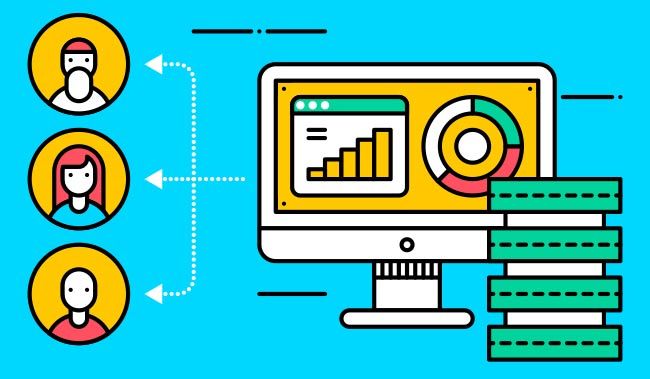27th August 2025

Content Guru discusses what a customer data platform is, how a customer data platform differs from the CRM, how a customer data platform helps businesses drive value from data and how customer data drives efficiency from businesses.
In 2025, global data generation hit 180 zettabytes. If that sounds made up, that’s because the scale is so hard to fathom. A zettabyte is 1,000,000,000,000,000,000,000.
All human speech ever spoken, if recorded at 16 kHz audio, would fill 42 zettabytes. And it’s no surprise that an exponential increase in data creation coincides with the introduction of the first LLMs in the early 2020s.
We live in a world that is saturated with data. That data is mined, constantly, for insights into individual behavior that might inform the delivery of services to customers.
That’s the origin of personalization – the idea that, with sufficient data, a company could create a seamless, personalized experience that makes every customer feel like a unique individual, and keeps them coming back.
Data-driven personalization is at the heart of Customer Experience (CX). Smart organizations know how to collect the data that matters and deploy it strategically. That requires specialized tools, and the most significant of these is the Customer Data Platform, or CDP.
A Customer Data Platform, or CDP, is software that creates a unified, persistent customer database by collecting and integrating data from various sources.
Essentially, the CDP is a data aggregation platform, bringing together information from myriad sources into a single, accessible interface.
Part of the reason why humanity’s data output is so vast is duplication – data saved in multiple places – and duplication costs businesses money.
The average employee works with around 14 different systems of record. Recording, retrieving, and managing duplicated data is costing businesses time and money.
The process of stitching together data from multiple systems of record, marketing platforms, CRMs to create a single, profile for each customer is known as identity resolution.
Once a single customer profile has been created, that customer needs to be traced across multiple devices. Whether the customer reaches out via phone, email, SMS, webchat, or social channels, the CDP regards them as a single customer – a truly omni-channel experience.
When unified within the CDP, data can be activated; that is, accessed by employees to support customer interactions or generate strategic reports, or by AI systems, to drive hyper-personalized self-service.
It’s also possible to bring data generated by Internet of Things (IoT) devices into the CDP. Devices like smart meters, intelligent home sensors, vehicle black boxes, and even healthcare devices can input data into the CDP in real time.
The potential here is for proactive customer service – identifying faults and reaching out to the customer, before the customer even knows what’s gone wrong.
With all this information in one place, the CDP can begin to craw insights from your data, identifying long-term trends, down to the individual level, to help you coordinate your customer care.
Think of the CDP as a system of action. Rather than just recording data, it enables you to use that data to take effective action to resolve customer issues, and create an outstanding customer experience.
A CRM, or Customer Relationship Management platform, is essentially a database. It’s a place where you can record customer data, to be accessed later.
It might come with tools and functions that make it easier to surface the right data, but that’s not guaranteed.
The problem is, most businesses (and in particular large enterprises) end up needing more than one CRM. Whether it’s because they need different functionality, or just a different location, CRMs quickly multiply.
CRMs are also prone to human error. When data is inputted by humans without oversight, mistakes and duplications inevitably creep in.
The CDP works to smooth over these cracks, creating unified customer profiles out of a fraying data tapestry. The CDP compensates for human error in data entry.
CRMs, then, are about owning data. CDPs are about transforming it into value. The CRM is a monolithic data structure; the CDP is a distributed data architecture.
Often, businesses think that one more CRM will be the key to solving their data woes, but that’s rarely the case. Effectively, that would just add another silo to an already heavily-siloed data architecture. What businesses usually need is the CDP.
THE CDP doesn’t just store data; it links together systems. That means that information from multiple CRMs and other systems of record can be brought into a single CDP, from where it can be accessed easily.
This presents a comprehensive view of your data, letting you get what you need, when you need it, without having to navigate between around 14 different systems. That saves you time and cuts costs. CDPs are built on integration, not accumulation.
This gives CDPs an added benefit: flexibility and integration. Implementing the CDP doesn’t require a costly and labor-intensive migration.
No copying of data across from your legacy CRM, with all the essential formatting issues that come with that. THE CDP integrates data from across your IT landscape, no matter the system or the format, to drive efficiencies.
To summarize, the key differences between the CDP and the CRM are:
So, how do CDPs transform businesses?
Not all data is created equal. The complete works of Shakespeare would only fill 5 megabytes. It’s safe to say that the vast majority of the data generated today is just noise. It’s not about volume, it’s about how you use it.
Smart businesses know what data matters, and how to make best use of it:
And the CDP benefits don’t stop at reactive customer service. By aggregating data from across your CRMs, you can begin to analyze trends, make predictions, and deliver proactive Customer Experience.
For instance, an insurer might reach out to a customer when the time comes to renew their policy, or a healthcare provider might use patient data to make recommendations for a healthier life.
Reviewed by: Jo Robinson